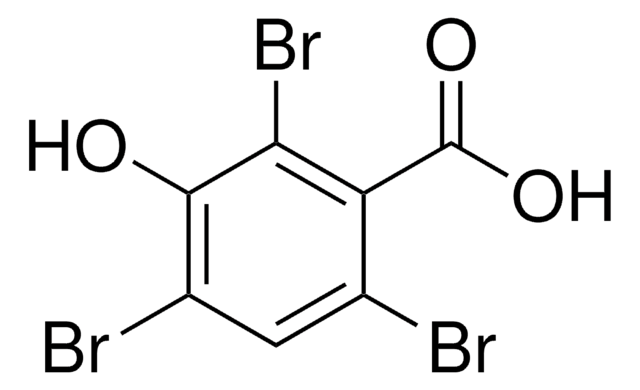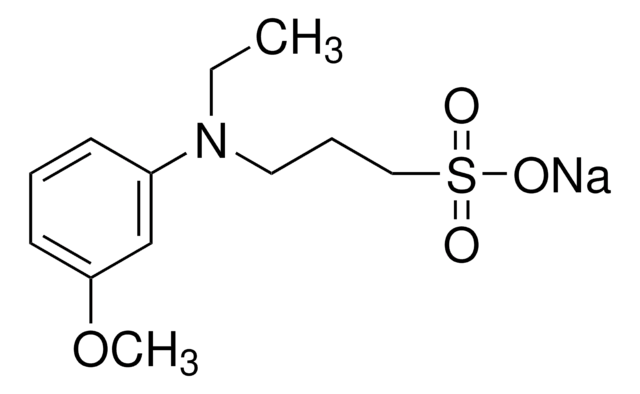06800
4-Aminoantipyrine
for spectrophotometric det. of H2O2 and phenols, ≥98.0%
Sinonimo/i:
4-Amino-2,3-dimethyl-1-phenyl-3-pyrazolin-5-one, Ampyrone
About This Item
Prodotti consigliati
Livello qualitativo
Saggio
≥98.0% (NT)
≥98.0%
Qualità
for spectrophotometric det. of H2O2 and phenols
tecniche
UV/Vis spectroscopy: suitable
photometry: suitable
Punto di fusione
105-110 °C (lit.)
108-110 °C
Solubilità
H2O: 0.1 g/mL, clear to slightly hazy
Stringa SMILE
CN1N(c2ccccc2)C(=O)C(N)=C1C
InChI
1S/C11H13N3O/c1-8-10(12)11(15)14(13(8)2)9-6-4-3-5-7-9/h3-7H,12H2,1-2H3
RLFWWDJHLFCNIJ-UHFFFAOYSA-N
Cerchi prodotti simili? Visita Guida al confronto tra prodotti
Applicazioni
- Cu-chelated polydopamine nanozymes with laccase-like activity for photothermal catalytic degradation of dyes.: This research highlights the synthesis of copper-chelated polydopamine nanozymes demonstrating laccase-like activities. These nanozymes enhance the photothermal degradation of dyes, providing a novel approach for environmental remediation (Wang et al., 2024).
- Tramadol and M1 Bioavailability Induced by Metamizole Co-Administration in Donkeys (Equus asinus).: This study explores the pharmacokinetic interactions between tramadol and metamizole in donkeys, offering insights into veterinary medicine and drug administration practices (Araújo-Silva et al., 2024).
- Pharmacokinetics-Based Pediatric Dose Evaluation and Optimization Using Saliva - A Case Study.: This paper presents a methodological innovation using saliva samples to optimize pediatric dosing of medications, which could revolutionize therapeutic drug monitoring in children (Anliker-Ort et al., 2024).
- Spectrophotometric determination of phenol impurity in phenoxyethanol and phenol index of drinking water and municipal wastewater effluent after salting-out assisted liquid phase microextraction (SA-LPME).: This study offers a spectrophotometric method for detecting phenol impurities, enhancing water quality monitoring techniques (Roustaei et al., 2024).
- A novel hybrid sensor array based on the polyphenol oxidase and its nanozymes combined with the machine learning based dual output model to identify tea polyphenols and Chinese teas.: This research introduces a hybrid sensor array employing polyphenol oxidase and its nanozymes for detecting tea polyphenols, showcasing the integration of enzymatic methods with machine learning for enhanced specificity and sensitivity in food analysis (Yang et al., 2024).
Altre note
Prodotti correlati
Avvertenze
Warning
Indicazioni di pericolo
Consigli di prudenza
Classi di pericolo
Acute Tox. 4 Oral
Codice della classe di stoccaggio
11 - Combustible Solids
Classe di pericolosità dell'acqua (WGK)
WGK 3
Punto d’infiammabilità (°F)
Not applicable
Punto d’infiammabilità (°C)
Not applicable
Dispositivi di protezione individuale
dust mask type N95 (US), Eyeshields, Gloves
Choose from one of the most recent versions:
Possiedi già questo prodotto?
I documenti relativi ai prodotti acquistati recentemente sono disponibili nell’Archivio dei documenti.
I clienti hanno visto anche
Il team dei nostri ricercatori vanta grande esperienza in tutte le aree della ricerca quali Life Science, scienza dei materiali, sintesi chimica, cromatografia, discipline analitiche, ecc..
Contatta l'Assistenza Tecnica.













